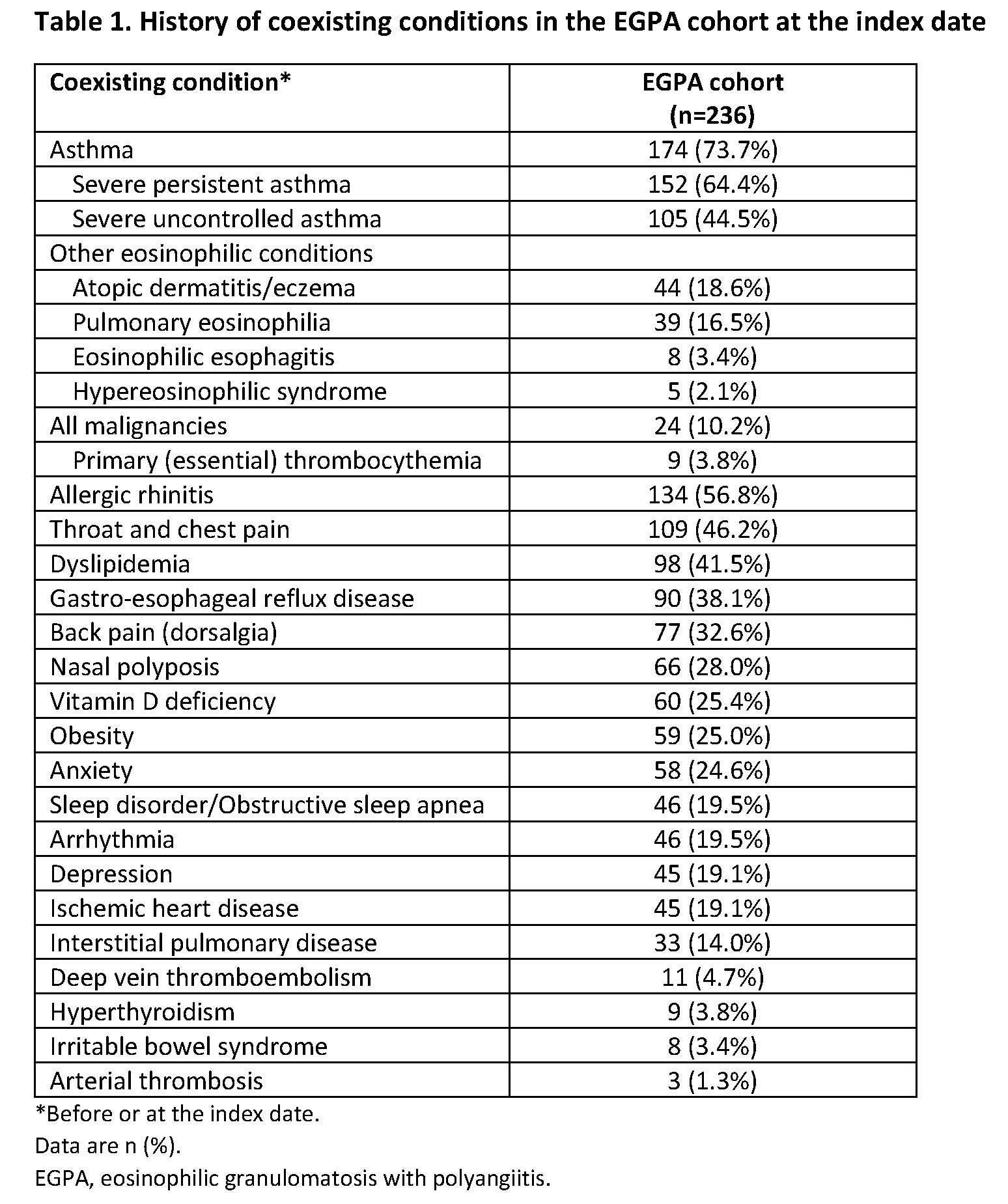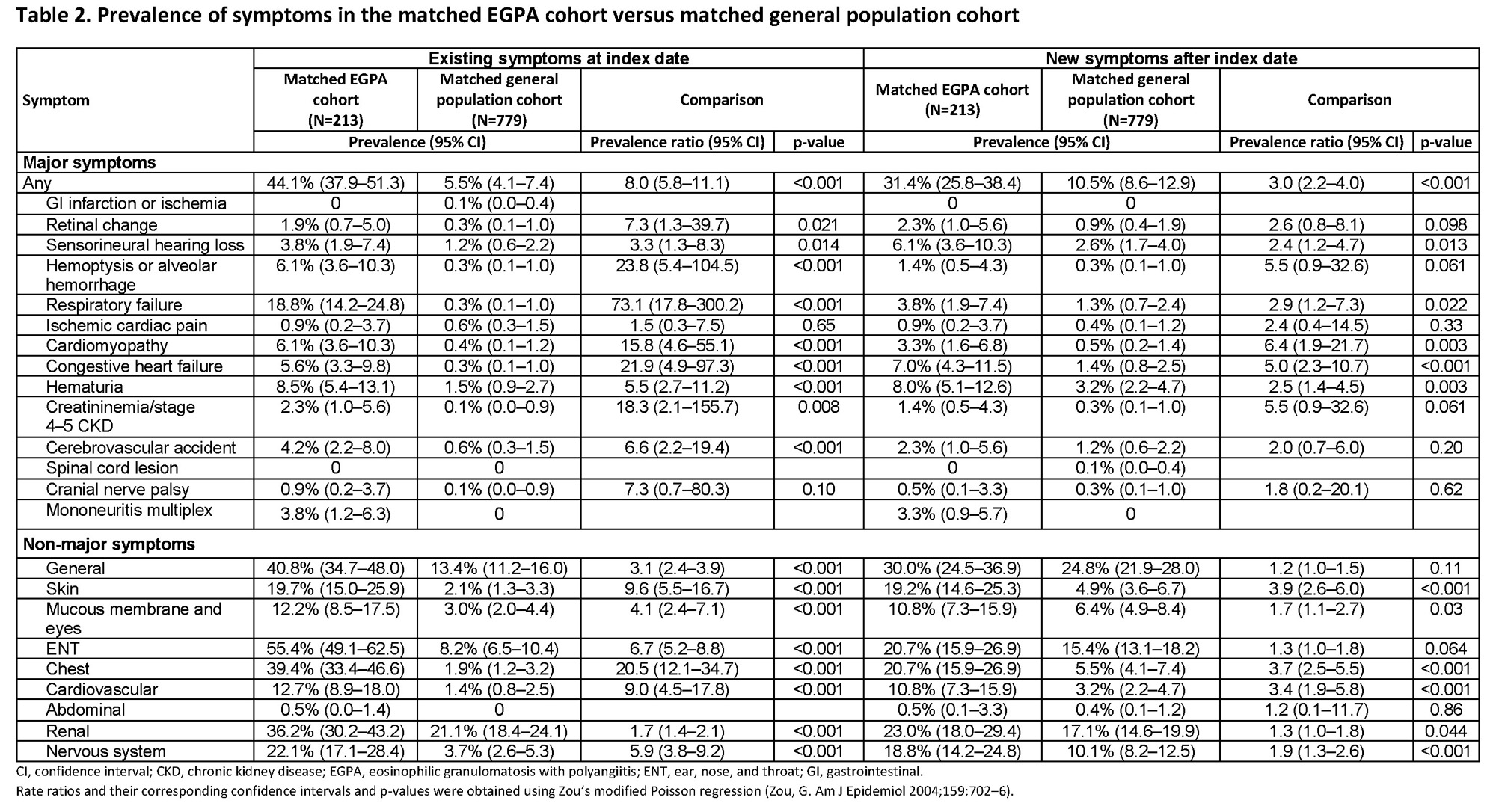Session Information
Date: Monday, November 13, 2023
Title: (1534–1553) Vasculitis – ANCA-Associated Poster II: Epidemiology, Outcomes, & Classification
Session Type: Poster Session B
Session Time: 9:00AM-11:00AM
Background/Purpose: Eosinophilic granulomatosis with polyangiitis (EGPA) is a rare necrotizing small-to-medium vessel vasculitis with a relapsing-remitting course involving prodromal (various allergic reactions), eosinophilic (infiltration into organs), and vasculitic (widespread inflammation of small and medium blood vessels) phases, with symptoms depending on the affected organ. Using a retrospective analysis of US administrative health insurance claims data (Merative™ MarketScan® databases), we assessed the clinical burden of EGPA.
Methods: Patients with newly diagnosed EGPA from 2017 to 2021 with ≥12 months of continuous pre-diagnosis health plan enrollment and ≥1 inpatient or ≥2 outpatient EGPA-related diagnoses (≥90 days apart, ICD-10-CM code M30.1) were included. Follow-up was from date of first observed EGPA diagnosis (index date; ID) until health plan disenrollment or database end. Major and non-major coexisting conditions and symptoms were analyzed in patients with EGPA and in a general population cohort matched on demographic characteristics.
Results: In total, 236 patients with EGPA were identified (‘EGPA cohort’); 88% had commercial insurance. At ID, mean (standard deviation [SD]) age was 50.4 (14.5) years, 88% were < 65 years, and 58% were female. Mean (SD) duration of follow-up from ID was 21.7 (14.6) months; 26% had ≥30 months’ follow-up. Of these, 213 patients with EGPA (‘matched EGPA cohort’) were matched to a general population cohort (‘matched general population cohort’; N=779; mean [SD] age 50.6 [13.7] years, 90% were < 65 years, 59% were female). The most common coexisting conditions at ID in the EGPA cohort were asthma (74% of patients), allergic rhinitis (57%), throat and chest pain (46%), and dyslipidemia (42%) (Table 1). After the ID, 79.2% of patients in the EGPA cohort reported ≥1 new EGPA symptom, with 31.4% experiencing a major symptom, of which the most common was hematuria (8.1%). At ID, in the matched EGPA cohort, 44% of patients had major symptoms, the most common of which were respiratory failure (19%), hematuria (9%), hemoptysis/alveolar hemorrhage (6%), and cardiomyopathy (6%). More patients in the matched EGPA cohort had a major symptom compared with the matched general population cohort at ID (prevalence ratio 8.0 [95% confidence interval (CI) 5.8–11.1]; p< 0.001) as well as new symptoms after ID (prevalence ratio 3.0 [95% CI 2.2–4.0]; p< 0.001) (Table 2). The symptoms with the three highest prevalence ratios in the matched EGPA cohort versus the matched general population cohort at ID were respiratory failure (73.1 [17.8–300.2]; p< 0.001), hemoptysis or alveolar hemorrhage (23.8 [5.4–104.5]; p< 0.001), and congestive heart failure (21.9 [4.9–97.3]; p< 0.001).
Conclusion: At ID, over 40% of patients with EGPA had major symptoms. New major symptoms continued to occur after ID, with many occurring significantly more frequently than in a matched population without EGPA. These data highlight the substantial burden of EGPA, with a large portion of symptoms within the respiratory system. Greater awareness of EGPA symptoms is needed to ensure proper disease management between different specialties and multidisciplinary teams.
To cite this abstract in AMA style:
Dolin P, Kielar D, Shavit A, Keogh K, Rowell J, Edmonds C, Meyers J, Esterberg E, Nham T, Chen S. Disease Burden of Eosinophilic Granulomatosis with Polyangiitis (EGPA): A Retrospective Analysis of US Health Insurance Claims Data [abstract]. Arthritis Rheumatol. 2023; 75 (suppl 9). https://acrabstracts.org/abstract/disease-burden-of-eosinophilic-granulomatosis-with-polyangiitis-egpa-a-retrospective-analysis-of-us-health-insurance-claims-data/. Accessed .« Back to ACR Convergence 2023
ACR Meeting Abstracts - https://acrabstracts.org/abstract/disease-burden-of-eosinophilic-granulomatosis-with-polyangiitis-egpa-a-retrospective-analysis-of-us-health-insurance-claims-data/


